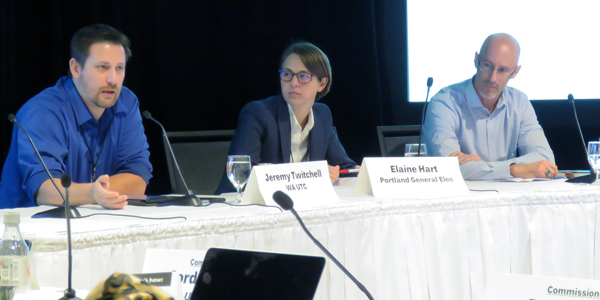By Jason Fordney
RENO, Nev. — Energy storage can provide many benefits to the Western electricity grid, but it will require complex and costly modeling to be integrated properly, a panel of regional energy experts said this week.
The power industry, and its regulators, will require a long-term effort to accurately analyze the benefits and costs of storage, the panel of utility representatives and others said during an Oct. 17 joint meeting of the Committee on Regional Electric Power Cooperation (CREPC) and the Western Interconnection Regional Advisory Body.
Sector participants must study what ancillary services and sub-hourly and locational benefits storage resources can offer along with the range of other uses being explored for the technology.
Fully modeling the impact of energy storage across the existing utility system “is going to be a very difficult nut to crack” and a big computational problem, said Elaine Hart, a Portland General Electric power analyst.
Oregon-based PGE has been using software tools to model storage, Hart said, utilizing a production cost model for its integrated resource plan (IRP) that simulates the electricity system and dispatch over 20 years and 30 different potential future scenarios based on gas prices, resource output, energy prices and other factors. The effort requires significant computing power and lengthy running of software programs to model possible outcomes.
“We are really lucky that we had this tool when we started evaluating energy storage,” Hart said. To reduce computational time, timelines for modeling could be expanded to every few years instead of every year, for example, and other adjustments could be made, she noted.
Getting it Right
The Washington Utilities and Transportation Commission is working to help that state’s investor-owned utilities integrate energy storage into their IRPs, commission energy adviser Jeremy Twitchell said. The regulator has directed utilities to improve their analysis of energy storage options, an initiative launched after it observed activities at FERC and in California, New York and around the country.
“The key takeaway as we looked around was there were niche storage applications at the time: There were cost-effective applications in a limited scope,” he said. The commission knew utilities needed to be more flexible and that technology costs were dropping, but its modeling capabilities were inadequate.
The commission felt that if it got the modeling right, utilities would integrate the technology in a cost-effective way, Twitchell said. It held workshops to identify challenges, bringing in national laboratories to provide modeling advice and finding that storage can perform well as frequency support and fast response. He also said storage should also be studied for its impact on the transmission and distribution grid, and not just as an IRP resource.
The UTC earlier this month issued a policy statement saying that the absence of an organized market in the West is creating many of the challenges of integrating energy storage, but Twitchell said that perspective is changing because regulated utilities can still capture the benefits of storage without relying on wholesale market outcomes.
FERC in January issued its own storage policy statement “to provide guidance regarding electric storage resources seeking to receive cost-based rate recovery for certain services while also receiving market-based revenues for providing market-based rate services.” According to FERC, the main issues around integrating storage relate to protecting cost-based ratepayers from the potential for double-recovery of costs, preventing adverse market impacts, and maintaining RTO and ISO independence from market participants.
Commissioner Cheryl LaFleur dissented against the policy statement, which was approved by former Chairman Norman Bay and former Commissioner Colette Honorable, saying she disagreed that the issue should be split off from a Notice of Proposed Rulemaking that FERC issued in November 2016.
Price Discovery

Travis Kavulla, CREPC co-chair and Montana Public Utilities Commissioner, asked the panel how more “price discovery” could be incorporated into the modeling process. He said that storage has generally been implemented in two ways: as a “mandate backed up with technocratic guess-work shoved into the rate base,” or with ISOs designing products that let batteries compete in markets.
Tucson Electric Power’s Lee Alter said that IRPs covering all resources could discover pricing and compare different technologies, and that studying storage “jibes really well with the IRP process.” He said his utility is beginning to model energy storage, including sub-hour modeling that serves to study not just integration of batteries, but other impacts from the Western Energy Imbalance Market, pumped storage and other resources.
The discussion made clear that modeling the impacts of energy storage, identifying the benefits and turning energy storage services into a consistent revenue stream will be an ongoing challenge for utilities, regulators and other stakeholders.




